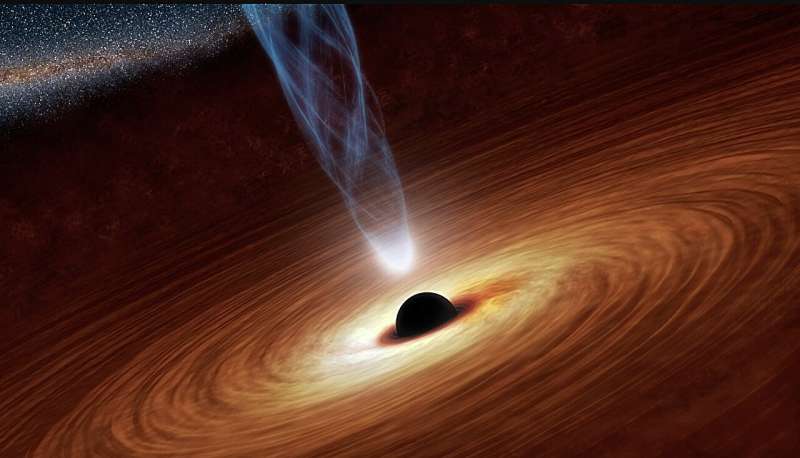September 22, 2023 feature
This article has been reviewed according to Science X's editorial process and policies. Editors have highlighted the following attributes while ensuring the content's credibility:
fact-checked
peer-reviewed publication
trusted source
proofread
Theoretical study shows that Kerr black holes could amplify new physics

Black holes are regions in space characterized by extremely strong gravity, which prevents all matter and electromagnetic waves from escaping it. These fascinating cosmic bodies have been the focus of countless research studies, yet their intricate physical nuances are yet to be fully uncovered.
Researchers at University of California–Santa Barbara, University of Warsaw and University of Cambridge recently carried out a theoretical study focusing on a class of black holes known as extremal Kerr black holes, which are uncharged stationary black holes with a coinciding inner and outer horizon. Their paper, published in Physical Review Letters, shows that these black holes' unique characteristics could make them ideal "amplifiers" of new, unknown physics.
"This research has its origin in a previous project started during my visit to UC Santa Barbara," Maciej Kolanowski, one of the researchers who carried out the study, told Phys.org. "I started discussing very cold (so called, extremal) black holes with Gary Horowitz (UCSB) and Jorge Santos (at Cambridge). Soon we realized that in fact, generic extremal black holes look very different than it was previously believed."
In their previous paper, Kolanowski, Horowitz and Santos showed that in the presence of a cosmological constant extremal black holes are affected by infinite tidal forces. This means that if living beings were to fall into the black hole, they would be crushed by gravity before they moved even remotely close to the black hole's center. Yet the team showed that if the cosmological constant is zero, as it is assumed to be in many astrophysical scenarios, this effect vanishes.
"The spark for the current paper arose at UC Santa Barbara's weekly Gravity Lunch," Grant Remmen explained. "Chatting with Horowitz after a talk on his work on black hole horizon singularities, I asked whether other effects could give rise to such phenomena. My previous work on effective field theories (EFTs), particularly development of physics models with quantum corrections, gave me an idea. Talking with Horowitz, I wondered whether the higher-derivative terms in a gravitational EFT (i.e., quantum corrections to the Einstein equations) could themselves lead to singularities on the horizons of extreme black holes."
After Remmen shared his idea with Horowitz, they started collaboration with Kolanowski and Santos, aimed at testing this idea via a series of calculations. In their calculations, the researchers considered Einstein gravity coupled to its leading quantum corrections.
"The Einstein equations are linear in the Riemann tensor, a mathematical object describing the curvature of spacetime," Remmen explained. "In three space dimensions, the leading corrections to Einstein are terms that are cubic (third power) and quartic (fourth power) in the curvature. Because curvature is a measure of derivatives of the spacetime geometry, such terms are called 'higher-derivative terms.' We calculated the effect of these higher-derivative terms on rapidly spinning black holes."
Extremal black holes rotate at a maximum possible rate corresponding to the horizon moving at the speed of light. The researchers' calculations showed that the higher-derivative EFT corrections of extremal black holes make their horizons singular, with infinite tidal forces. This is in stark contrast with typical black holes, which have finite tidal forces that only become infinite at the center of the black hole.
"Surprisingly, EFT corrections make the singularity jump all the way from the center of the black hole out to the horizon, where you wouldn't expect it to be," Remmen said. "The value of the coefficient in front of a given EFT term—the 'dial settings' in the laws of physics—are dictated by the couplings and types of particle that are present at high energies and short distances. In this sense, EFT coefficients are sensitive to new physics."
Kolanowski, Horowitz, Remmen and Santos also found that the strength of the divergence in tides at the horizon of extremal black holes, and the possible occurrence of tidal singularity, heavily depends on the EFT coefficients. The results of their calculations thus suggest that the spacetime geometry near the horizon of these black holes is sensitive to new physics at higher energies.
"Interestingly, this unexpected singularity is present for the values of these EFT coefficients generated by the Standard Model of particle physics," Remmen said.
"Our results are surprising, since they imply that the low-energy description of physics can break down in a situation where you wouldn't expect that to happen. In physics, there's usually a sense of 'decoupling' between different distance scales. For example, you don't need to know the details of water molecules to describe waves using hydrodynamics. Yet for rapidly spinning black holes, that's precisely what happens: the low-energy EFT breaks down at the horizon."
Overall, the calculations carried out by this team of researchers hint at the promise of extremal Kerr black holes for probing new physical phenomena. While the horizon of these black holes can be very large, it was not expected to have an infinitely large curvature (i.e., infinite tidal forces) in the EFT. Their results show that it does.
"In future work, we are interested in exploring whether the singularities can be resolved by ultraviolet physics," Remmen added. "A pressing question is whether the sensitivity of the horizon to new physics persists all the way to the Planck scale, or whether the horizon 'smooths out' at the short-distance scale associated with the EFT. We are also looking for other situations in which short distance effects might show up unexpected at large distances."
More information: Gary T. Horowitz et al, Extremal Kerr Black Holes as Amplifiers of New Physics, Physical Review Letters (2023). DOI: 10.1103/PhysRevLett.131.091402
Journal information: Physical Review Letters
© 2023 Science X Network




















